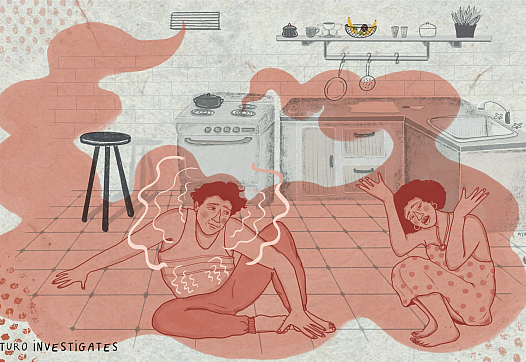They Survived a Fire in Harlem. Now They are Fighting Their Landlord and The City for Answers.
This project was originally published in Futuro Unidad Hinojosa with support from our 2022 Data Fellowship.
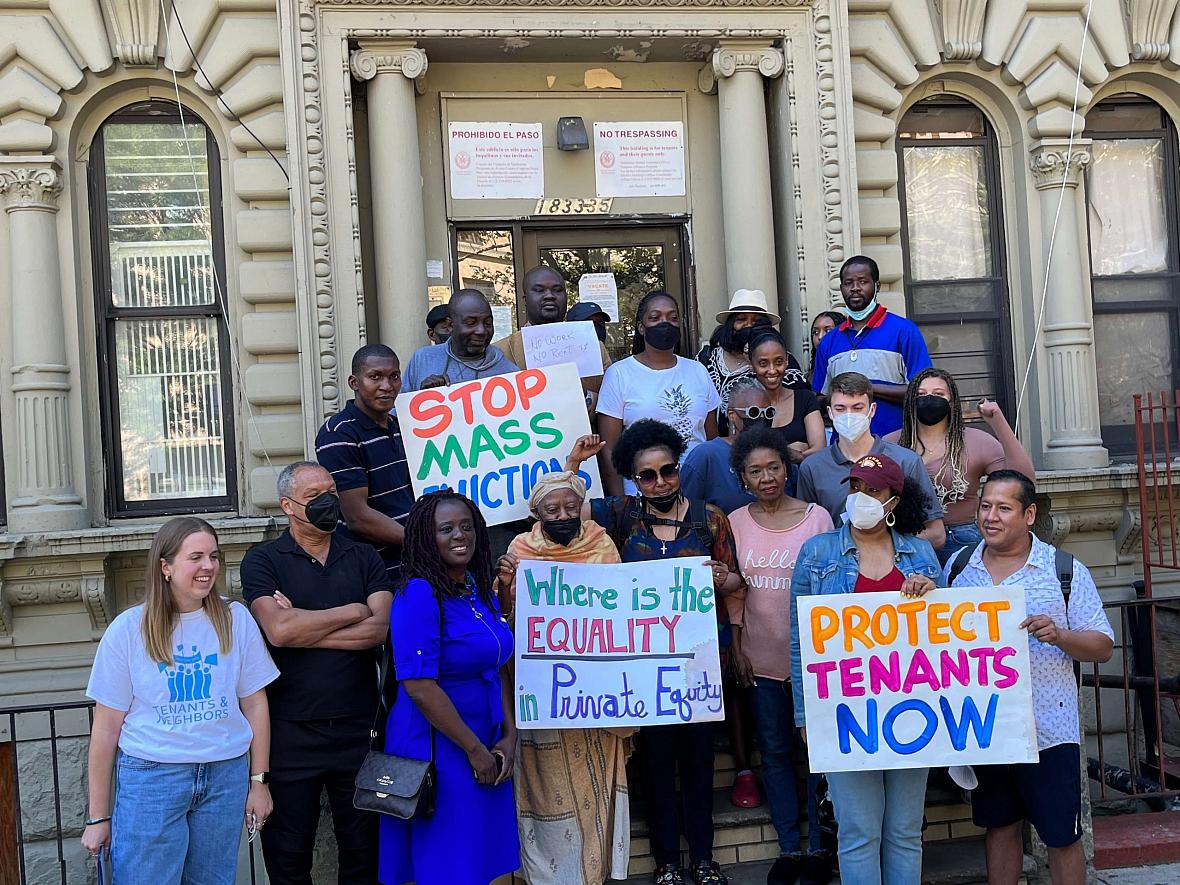
[This is the second story in the series “Air We Can’t Grasp: The Insidious Matter of Carbon Monoxide.”]
One of the images Efrain Sarmiento remembers in the aftermath of the fire at his Harlem apartment is black handprints made of soot imprinted on the walls of the complex. After having a night out, he returned home to fall asleep on the couch in his one-bedroom apartment. In the middle of the night, he woke up to the smell of smoke. He didn’t hear any fire alarms go off.
When he opened the door to his apartment, all he could feel was a rush of heat over his face and body. He saw what he describes as pitch-black smoke. Afraid, he immediately closed the door. Out of panic, he grabbed his wallet and threw it out the window, with other belongings. Shoes. Jackets. Passport. Anything he thought was important. He climbed out his living room window and down the fire escape of his five-story building. He made it to the second story. Then, the ladder to reach the ground floor didn’t work.
“So I had to jump,” he said, to get out before it was too late.
Sarmiento remembers neighbors coming outside in the cold fall night in sheer panic. And others running outside, naked, to escape the flames.
More than 100 firefighters responded to the emergency at 1833 Adam Clayton Powell Boulevard, which started at about 1:30 am on an early Friday morning.
“You want to erase it from your mind. You want to erase it from your spirit,” Sarmiento said about the blaze.
After the fire, he would avoid coming home, because of the trauma. Sometimes he’d stay out as late as possible, or he would end up sleeping at a friend’s house. The sound of sirens would trigger him. Months after the fire, he could still smell the scent of smoke in the building.
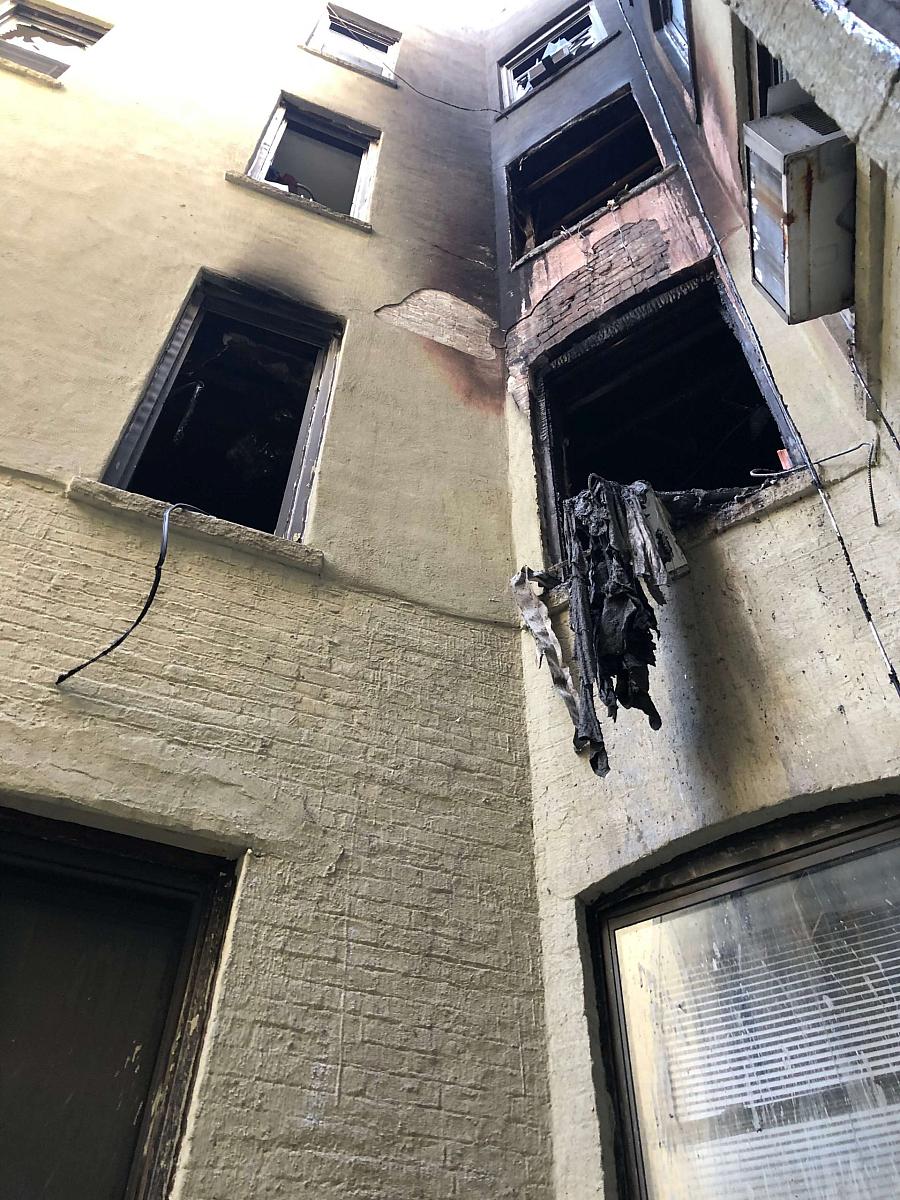
Damage after a deadly fire killed three people and injured others in the Harlem building in November 2019. Several families were displaced in the aftermath.
Tanya Turner
A Deadly Cost
Three people died after that November 2021 fire in Harlem. A mother in her 30s, her three-year-old child and a man in his 80s, a Vietnam veteran and retired music teacher. At least two of them died from smoke inhalation in the fire.
A few of Sarmiento’s neighbors also suffered from the effects of smoke inhalation. After the fire, some neighbors eventually moved out, or were placed in the shelter system, due to the damage to their homes. Others, like Sarmiento, live with the memories and trauma of surviving the fire.
Sarmiento said there weren’t fire detectors installed in his floor’s hallway. When he asked around, he found out that many of his neighbors didn’t have functioning detectors, either.
Sixteen tenants have sued the landlord, Manhattanville Holdings, LLC for missing or broken smoke and carbon monoxide detectors, among other housing violations.
They’ve also sued city agencies, including the New York City Department of Housing Preservation and Development (HPD). One of the many things the tenants’ group wants is to be awarded costs for relocation and storage as well as reimbursement for the damages in their apartments from the fire.
Smoke and carbon monoxide detectors are required in all New York City apartments, but housing violations related to fire safety still occur. Data analysis by Futuro Investigates shows that most carbon monoxide-related violations occur in The Bronx, Brooklyn and Manhattan.
- For more data analysis and our coverage of carbon monoxide poisoning in New York City, also read “What To Know To Stay Safe From Carbon Monoxide Poisoning”
According to data on NYC’s Environmental and Health Data Portal, Central Harlem ranks at the bottom third when it comes to housing maintenance issues including peeling paint, homes with cracks and holes and carbon monoxide incidents as a result of not having a detector.
As of this report, the building has more than 80 open housing violations dating back to 2015 – some of which are awaiting confirmation from HPD to be closed. Furthermore, the most common 311 calls from tenants over the last three years are complaints related to lack of heat and hot water, plumbing issues and problems with plaster and paint.
Though Manhattanville Holdings, LLC is named in the lawsuit, other city documents show that the building was purchased in the year 2013 by 1829 -1835 7 LLC. Both companies have the same Brooklyn address.
The lawyer representing Manhattanville Holdings, LLC in the lawsuit didn’t return requests for comment from Futuro Investigates.
A Simple Fix
Most people who pass away in fires don’t die from the fire itself but from smoke inhalation. Carbon monoxide poisoning is the leading cause of death when it comes to smoke inhalation. Smoke from fires has air pollutants: carbon monoxide, carbon dioxide and soot (particulate matter).
One example of how deadly smoke can be is the Twin Parks fire in the Bronx that killed 17 people in 2022. All of the victims died of smoke inhalation.
Smoke alarms and carbon monoxide detectors work pretty simply and are cost-efficient. A smoke alarm is set off by sensing small particles in the air, costing as little as $10. A CO detector measures the amount of carbon monoxide in the air in parts per million and can cost as little as $20. If working correctly, both detectors will send an alarm when there is a dangerous amount of smoke and carbon monoxide in an area, in time for people to escape and avoid injury or worse.
More than six months after the fire at the 1833 building, there was still soot throughout Sarmiento’s apartment. He also faced other hazards in his home, such as sparks shooting out of electric outlets in his kitchen, outlets, and his fuse box. On top of that, he had a leaky roof.
Other residents needed repairs in their apartments in the aftermath of the fire. There were also broken windows, melted floors and loud radiators emitting fumes in the hallways.
Frustrated with these unattended repairs, residents organized and filed a lawsuit in June 2022. “It’s just a constant battle,” Sarmiento said, “to get the humane things done for our building.”
Who Lives In Harlem
The people who live in the nearly 50 apartments in 1833 are a microcosm of Harlem. One tenant has lived in the building her entire life. Another one moved from the Midwest just months before the fire. Some are native New Yorkers. Others are immigrants.
Originally from Texas, Sarmiento has lived in Harlem on and off for about 20 years. His apartment is filled with some of his own abstract paintings, a keyboard and a puzzle from The New Yorker. He plays the piano, guitar and trumpet. Months after the holidays, a tiny Christmas tree decked with red ribbons, sparkly baubles and a gold star at the top sits next to his flat-screen television.
“I love Christmas,” he says. “It’s a happy feeling.”

Efrian Sarmiento has lived in his one-bedroom apartment since June 2021 – just five months before a fatal fire killed three of his neighbors.
Roxanne Scott
Sarmiento likes that his apartment is close to Central Park North, a public pool and shopping on 125th street.
“It’s a city within a city,” he said about Harlem.
Traditionally a Black neighborhood from at least the 1900s, more recently the Black population steadily continues to drop. In Manhattan Community District 10, which includes Central Harlem, nearly a quarter of residents are immigrants. More than four in every ten residents are Black and nearly one in every three are Latino.
Sheena Morrison, a long-time Black resident, has lived in the 1833 building since 1982. She’s from Harlem and this was her first apartment.
“It's always been home,” Morrison said.
She remembers sitting on stoops and hanging out with friends on the corner in her younger years.
“Every block has their folks,” she said. She also remembers the days it would be difficult to get food delivery, as no one wanted to come to Harlem because of fear of crime. Now, there’s a plethora of sit-down restaurants.
In the early aughts, she recalls more white people moving to the neighborhood.
She said the area now contains a mix of safe havens for affluent residents.
“And then you have the dilapidated deteriorating sections from one block to the next, like on Seventh Avenue [Adam Clayton Powell Jr. Boulevard], where we live,” she said.
Much of the housing in the neighborhood are pre-war buildings, like the 1833 building, as well as brownstones. The corners in Central Harlem are packed with gourmet delis and bodegas. Streets are lined with senior centers, Citi Bikes and community gardens. Vendors sell strawberries, bananas and tangerines near chic restaurants and long food pantry lines.
Known Violations
Sarmiento knew about problems in his building before he moved into the complex in June 2021, tired of paying $200 to $300 a night for a hotel room. He had a history of bad credit and had trouble finding a place that would rent to him. A broker eventually found an apartment owner willing to work with him as long as he had proof of income.
“I was desperate,” said Sarmiento. So he took the apartment in the rent-stabilized building. He currently pays about $2200 per month for his one-bedroom apartment. Sarmiento called the price a bargain.
As soon as he moved in, the problems became very apparent. There was no refrigerator or stove. His sink was always leaking. The elevator kept breaking down. He noticed rodents.
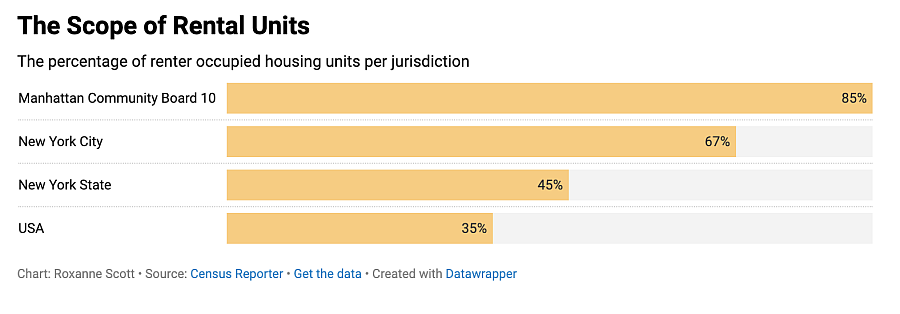
The percentage of renter occupied housing units per jurisdiction
Chart: Roxanne Scott Source: Census Reporter Get the data Created with Datawrapper
Morrison, the long-time tenant, said she’d seen the building change management and ownership more than a few times. The only consistency, she said, has been how poorly they have treated renters.
Sometimes there would be promises to make needed repairs. “And then they do just the minimum,” said Morrison.
She recalls one time when she needed a refrigerator. She was sent one, full of roaches.
According to the latest NYC Housing and Vacancy report, Black and Latino renters, regardless of income, make up the largest percentage of renters with three or more home maintenance deficiencies. That includes the broken elevator in 1833, rodents and water shutoffs.
“There were a lot of HPD violations in the building, both for common areas and individual apartments that date back to 2015,” says Rakhil Tilyayeva, a lawyer at Legal Services NYC representing some of the tenants in the lawsuit. Some of those violations were for fire safety conditions, including lack of self-closing doors, inoperable smoke, and carbon monoxide detectors.
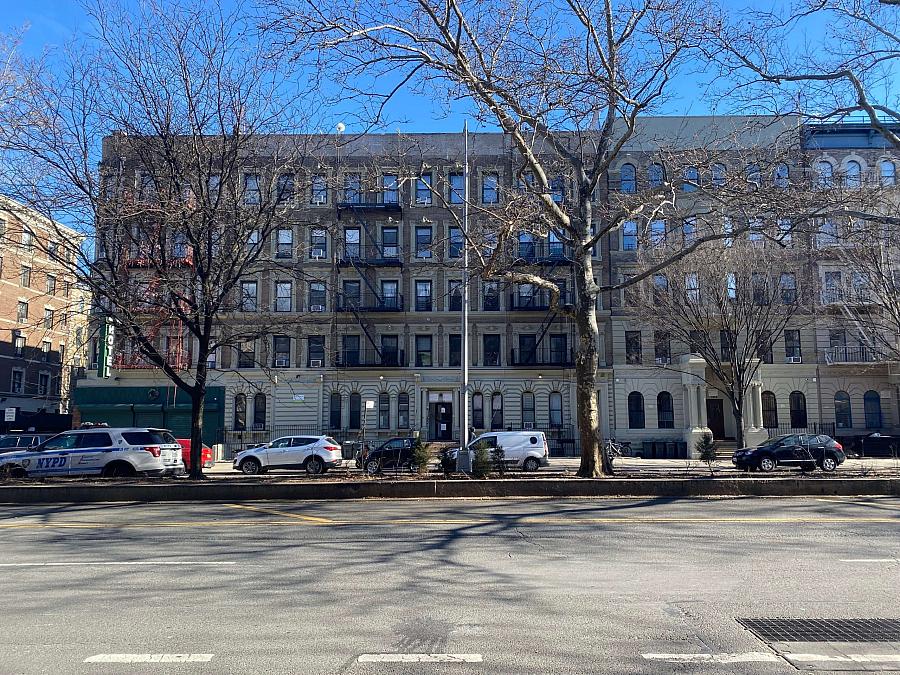
The building where the deadly fire happened in November 2019. It’s just north of Central Park on Adam Clayton Powell Jr Blvd. Because of its closeness to Central Park, restaurants and 125th Street, Efrain Sarmiento, a tenant, jumped at the chance to live in the building.
Photo Credit: Roxanne Scott
“Because the landlord had allowed a lot of these violations to go unaddressed for many years, ultimately we believe that did result in this fire being exacerbated by these conditions at the very least,” Tilyayeva said.
HPD currently has 292 housing inspectors, according to the agency. Their work includes investigating complaints made by tenants, such as lack of heat or hot water, issues around lead-based paint and making sure apartments have working detectors. Advocates say that number is not enough for the sheer number of housing complaints.
When asked by Futuro Investigates about the agency’s ability to keep up with hazardous housing violations, HPD said in a statement, “We have confidence in our housing inspection team’s ability to meet the needs.”
Regarding the lawsuit, the agency said, “As with any tenant-initiated litigation, HPD’s role is to ensure that the property owner complies with the Housing Maintenance Code.” The code includes protecting tenants from unsafe conditions.
Residents Take Action
Morrison said that, after the fire, there was a lack of communication from building management. There was no timeline as far as when things would be repaired.
“It was just more of the same essentially,” she said.
Neighbors in the building began to organize and started a tenants association. Tenants wrote a demand letter to their landlord expressing their frustration and asking for fixes to much-needed repairs.
“In fact, seven months later, we now find that we have no super, no working elevator and our most basic repairs have been ignored,” the letter read.
When those repairs didn’t happen, they decided enough was enough. In June 2022, seven months after the fire, tenants filed a lawsuit.
“I think that our starting the tenants association just came out of frustration of ‘they’re not responding to basic repairs,” said Morrison.
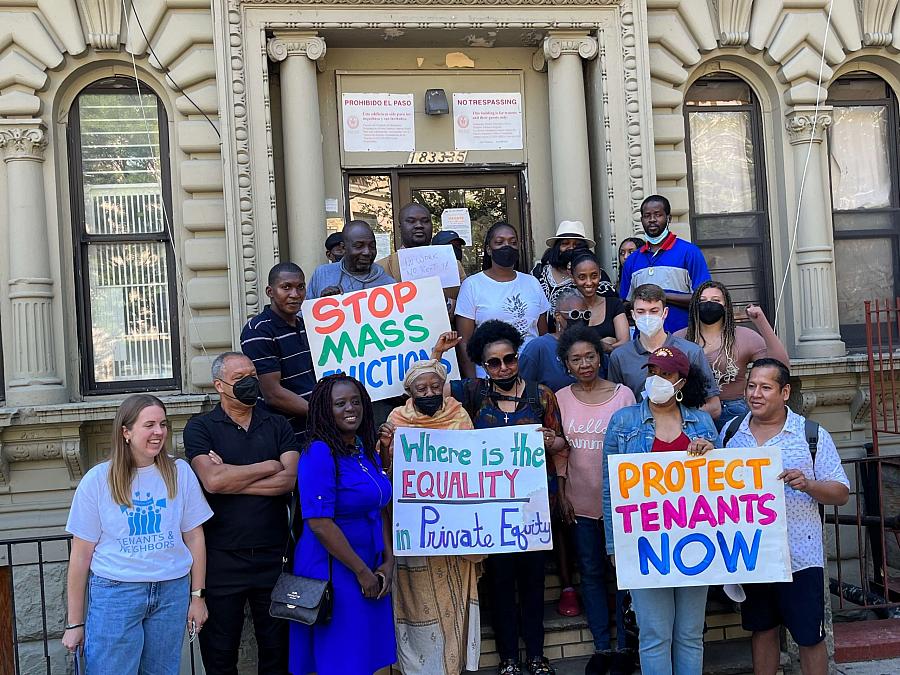
Tenants held a press conference in June 2022 outside of their Harlem apartment complex. Residents announced that they are suing their landlord as well as going on a rent strike until essential repairs in the building were made.
Legal Services NYC
In tandem with the lawsuit, tenants decided to hold a rent strike. Some tenants are refusing to pay rent until a specific list of demands is met. This can be a useful tactic against unyielding landlords, but sometimes carries the risk of eviction and bad credit history, says Tilyayeva, the lawyer representing tenants.
She said that rent strikes are legal and that tenants can withhold their rent until repairs and essential services are provided. The potential downside is that tenants may be put on a blacklist. Those kinds of lists are illegal in New York State, but it can be difficult to enforce the law, she said.
Something Unexpected
In early April, a tenant emailed the management company asking for a camera or new security system as it was suspected that someone was setting the building’s front door to not close and lock.
The response was that there was a new property manager.
“So that’s how we found out,” Morrison said.
Morrison added that she later received a letter informing tenants that Manhattanville Member, LLC now manages the building.
Tilyayeva, the lawyer representing tenants, was surprised when she learned about the change. Morrison was annoyed by the switch in property management but not surprised. She’s seen management of the building change often.
For now, the lawsuit still stands and residents continue to set aside their rent until a court determines what happens to their case.
Morrison hopes that the new management can break from the past pattern and uphold the basic contract between residents and landlord: we pay rent and you make repairs, especially ones that make sure tenants are safe.

